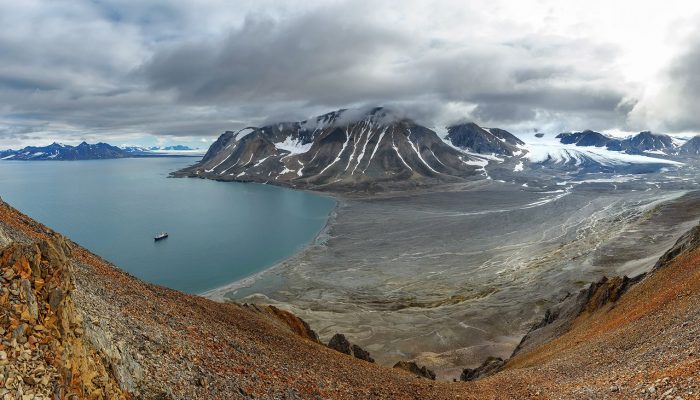
Communicating the fragility of one of Earth’s remotest environments is hugely difficult, precisely due to the location of the poles. Jon Fuhrmann, a freelance science writer and guide on Antarctic cruises, discusses the potential benefits of taking tourists to these once inaccessible locations, especially when it comes to making members of the public aware of the challenges faced by the Earth’s polar regions.
In the 200 years since the Antarctic mainland was first sighted by sealers intent on opening up new hunting grounds, our relationship with the seventh continent has undergone a remarkable transformation.
During the early 20th century – the so-called Heroic Age of Antarctic Exploration – explorers such as Amundsen, Shackleton and Scott became household names. But even then, Antarctica was something to be ‘conquered’, perhaps even defeated.
Today, while the first glimpse that most visitors get of Antarctica is still most likely to be from a ship, the circumstances could hardly be more different. A growing number of ice-strengthened expedition cruise ships, custom-built for exploring some of the remotest parts of the world, visit these waters and open up the Antarctic for curious tourists. The experience on these ships is very different from the shopping centres, water parks, variety shows and thousands of passengers that are commonly associated with cruise ships. As a guide on Antarctic expedition ships visiting the polar regions, I want to provide an insight into the world I am privileged to be a part of.
When confronted with the notion of human life in Antarctica today, most of us think of remote research stations, tiny outposts of civilisation in the icy wastes of the frozen continent. This is largely thanks to the Antarctic Treaty, which came into force in 1961 and stipulates that “in the interest of all mankind…Antarctica shall continue for ever to be used exclusively for peaceful purposes”. No territorial claims are recognised under the Treaty, and any military use or mineral exploitation is prohibited – essentially, the whole continent is a reserve for peaceful undertakings such as research, and increasingly also tourism.
The enduring tenets of the Treaty mean that Antarctica is no longer a mere resource to be exploited or capitalised on. It remains a continent that truly belongs to nobody – or, even if not many of us set foot on it, to everybody.
The lure of such a remote place surrounded by countless tales of heroism and discovery is a powerful draw not just for the polar scientific community. Swedish-American explorer Lars-Eric Lindblad – a firm believer in the benefits of ecotourism – recognised this and brought a purpose-built expedition cruise ship to Antarctica in 1970. The tourists were accompanied by expert guides who provided lectures, guidance and in-depth knowledge of the region. They used small rigid-hull inflatable boats to land on exposed shores in remote parts of the Antarctic peninsula.
This basic concept of a cruise that turns tourists into ambassadors for the regions they visit has proven enduring and extremely successful. By the mid-1980s, the tourists visiting Antarctica began to outnumber the scientific and support staff working at research stations. However, tourism is not as tightly regulated by the Antarctic Treaty as science and fisheries, the other two main activities in the region. In order to protect the Antarctic environment and wildlife and to minimise the impact of visits, tour operators themselves grouped together to form the International Association of Antarctica Tour Operators (IAATO) in 1991. IAATO is an invited expert group at Antarctic Treaty meetings and provides advice for Treaty members on tourism-related matters.
Ships operated by IAATO members avoid visiting ecologically sensitive sites during the breeding season and uphold strict standards of biosecurity for passengers and staff alike to avoid introducing non-native species into the fragile Antarctic ecosystem. Improved co-ordination between ships also ensures that sites do not become crowded. Despite the growing visitor numbers – last year, over 43,000 tourists visited Antarctica on expedition cruise ships – Lars-Eric Lindblad’s guiding principles of responsible tourism and environmental stewardship are still the central tenets of expedition cruising.
The responsibilities of guides like myself – many of whom are polar scientists in various disciplines themselves – are manifold. On board, while the ship makes the 1.5-to 3-day crossing from Patagonia to the Antarctic peninsula, we familiarise passengers with the Antarctic Treaty System and IAATO rules and regulations surrounding our visit, such as minimum distances from various species and guidelines on the interaction with historical sites.
But the lecture theatres and panoramic lounges of expedition ships are also perfect arenas for communicating polar science. As specialists in various aspects of the Antarctic – most ships will have experts in geology, marine biology, ornithology, history and a range of other subjects on board – we also give lectures to place the visit in a wider context and to help passengers understand what they are seeing.
Levels of knowledge among Antarctic tourists vary widely. Finding the right tone for an audience consisting of seasoned polar travellers as well as passengers with practically no pre-existing knowledge is key. Lectures, even ones on complex topics, are generally very well attended and attract many follow-up questions, highlighting that such cruises are viewed as an educational experience as well as the holiday of a lifetime. Outside of lectures, passengers also have access to their guides throughout the day, providing opportunities for more in-depth follow-up conversations.
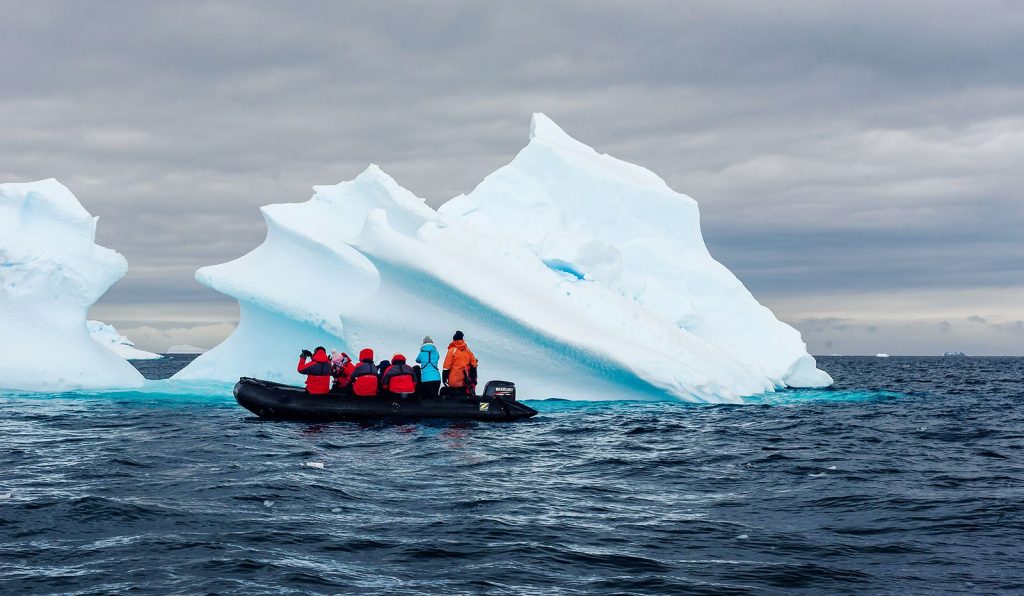
A zodiac with curious tourists cruises near an iceberg in Cierva Cove, Antarctic peninsula. Credit: Jonathan Fuhrmann.
If conditions permit, we take passengers to shore twice a day, with the ship relocating between morning and afternoon landings. We use rigid inflatable hull boats, colloquially known as ‘zodiacs’, and aim to spend several hours on land every day.
There is also an option to go on a ‘zodiac cruise’, a small-boat outing of up to two hours that allows us to approach places that can we could not reach on foot or with the ship. Landings and zodiac cruises usually take place at remote beaches, with the aim to observe wildlife, visit historical monuments or – where the landscape permits – to go for short hikes.
Occasionally, we also have opportunities to visit working research stations and to gain an insight into the work that takes place at these stations. Station staff are often excited to have visitors, and they regularly find themselves inundated with questions not just about life on station, but more specifically about their research.
In the evening, there is another opportunity to discuss specific things we observed during the day in a recap session – an open forum that encourages questions from passengers and further discussion with guides. We consider it our duty and passion not only to show our guests the “pretty face” of Antarctica, but also to ensure that they leave the ship with a better understanding of the Earth system.
But the most important educational aspect of expedition cruises to Antarctica is that the evidence we show in charts and figures is often also visible right outside our windows. When the ship can navigate into the head of a fjord that is uncharted because the water was only exposed as a result of recent glacial retreat, this is a powerful and real demonstration of the rapid changes we observe in the polar regions.
From an ecological perspective, visitors to South Georgia this year are far more likely to hear the song of the South Georgia pipit than in previous seasons. The island’s only songbird is fast returning to areas where invasive rats previously prevented it from breeding. This is an indicator of the likely success of the rat eradication project for the island, which is currently entering the observation phase.
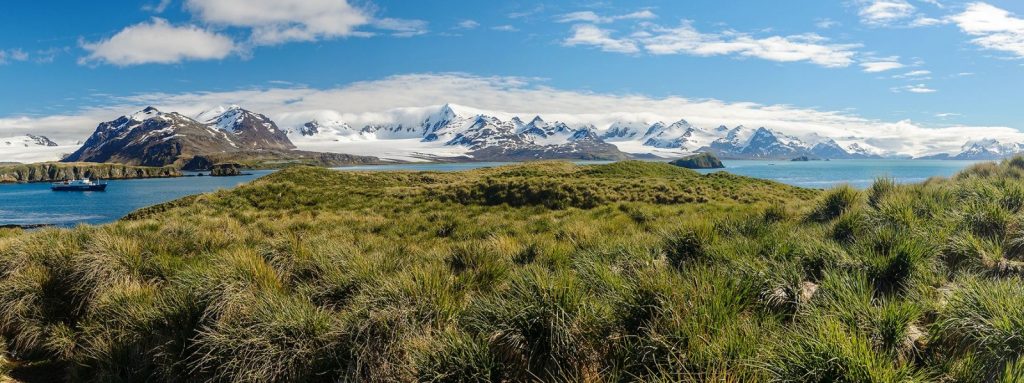
An expedition ship at anchor off Prion Island. The western end of South Georgia island rises in the background. Credit: Jonathan Fuhrmann.
Of course, there are challenges and issues surrounding expedition cruising, particularly as a result of the rapid growth the sector has experienced in recent years. It is not just the number of ships that is on the rise, but also the average size of vessels visiting the Antarctic: many of the new ships entering the market each year have space for close to 200 passengers (this is IAATO’s limit for the number of people allowed at most landing sites). Ships with more than 200 passengers are limited in the number of sites they can visit, while even larger vessels with more than 500 guests on board cannot land at all.
In response to the growing number of ships and people in remote parts of the polar oceans, the International Maritime Organisation‘s (IMO) Polar Code came into force 2017. Under the mandatory Polar Code, ships visiting the Arctic and Antarctic must adhere to stringent regulations regarding waste discharge and safety features, and they may not carry or use heavy fuel oil. Despite these positive developments, each vessel does increase the quantity of fuel burned in the Southern Ocean as well as the risk of accidents in very remote areas.
It is also important to bear in mind that we are visiting locations and ecosystems that are undergoing rapid change. What little plant life exists in the Antarctic grows extremely slowly and takes a long time to recover from disturbances such as the passage of even a few pairs of boots. In some places, evidence of minor disturbances as a result of tourism can be found. While the IAATO rules evolve in response to such findings in an effort to protect disturbed sites, the nature of Antarctic ecosystems is such that recovery can take a long time.
On the other hand, tourism and the presence of humans does not seem to have a significant impact on the breeding success of penguins, which rank among the most ‘popular’ and charismatic inhabitants of the Antarctic.
In order to minimise disturbance to the Antarctic and to ensure sustainable visits, it is essential that IAATO and the environmental community, spearheaded by the Antarctic and Southern Ocean Coalition, continue to work together to monitor and manage the impacts of Antarctic tourism.
On board visiting ships, steps are being taken to formalise the training of guides and expedition staff. Training and accreditation programmes such as the Polar Tourism Guides Association aim to ensure that guides uphold the highest standards of professionalism and environmental consciousness, ensuring that visitors to the Antarctic have a safe as well as sustainable experience.
Overall, it is important that we weigh the value of Antarctica as a place for science as well as tourism against the environmental impacts on one of the last relatively untouched places on Earth. Everyone involved in Antarctic ecotourism – from guides, to ships’ officers, to visitors – is keen for it to be a driving force for, rather than a hindrance to, conservation and environmental protection. I am confident that by taking visitors to the Antarctic and enhancing their knowledge, we produce thousands of ambassadors every year who take home important knowledge and calls for action regarding conservation, environmental protection and polar science.
By Jon Fuhrmann, freelance science writer
Editor’s note: This is a guest blog post that expresses the opinion of its author, whose views may differ from those of the European Geosciences Union. We hope the post can serve to generate discussion and a civilised debate amongst our readers.

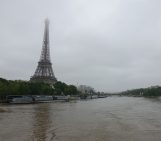
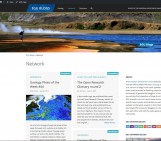


Elna@YoNature
Very nice post, I enjoyed reading it. I just came across a paper on climate change and tourism in the Antarctic and the paradox that the situation presents as in trying to find the balancing ground between tourism development and socio-economic gains and protecting an environment that is already deteriorating due to global warming. All in all, I guess that if we stick to sustainable tourism with an aim to raise awareness on what we could lose if we don’t take measures now, Antarctic tourism could be leading the way to the reality of climate change.
Thanks for sharing Jon.
Cheers, Elna
Mike Louagie
Thanks for this excellent article. We are building a dedicated website for expedition cruising, and this kind of articles is very useful.